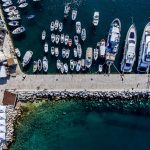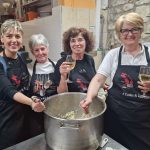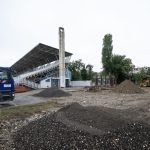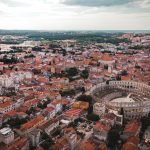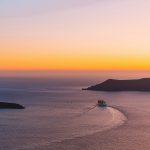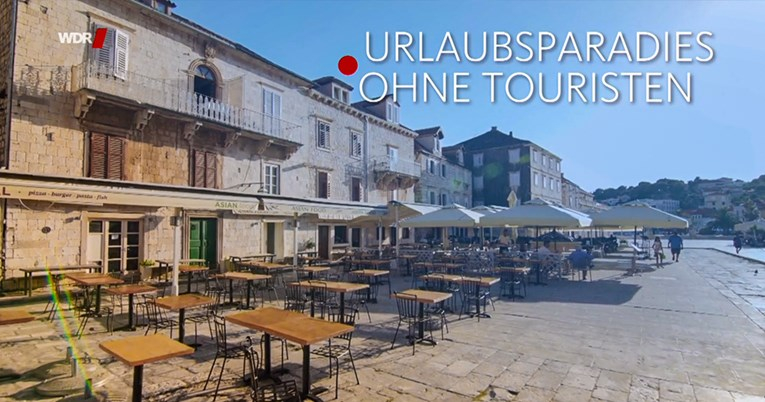
August 20, 2020 – German television WDR published a 45-minute report on Croatian tourism this year, which it called “Paradise for a vacation without tourists”.
Index.hr reports that it is a continuation of a report from two years ago, which dealt with the problems of Croatian tourism, such as the overcrowding in Dubrovnik. However, the coronavirus pandemic has changed everything.
“For tourists, this is an ideal situation because they have almost the entire coast to themselves, while the locals worry about whether they will survive financially and how to survive,” the beginning of the WDR report states.
The impact of the pandemic on Croatian tourism
A Croatian waiter tells them: “Of course I am afraid of the future, I don’t know who I could work for at all. Everyone here lives from tourism.” Shots of Dubrovnik’s rather empty streets follow, incomparable to the hustle and bustle filmed by German journalists two years ago at the same time.
“How hard has the corona crisis hit Croatia? How does it affect tourism? And how do people deal with it?” are questions that WDR is trying to answer.
Dubrovnik without tourists
They say that Dubrovnik is almost empty, so it is not difficult to keep a distance because there are simply no people. On the other hand, one Dubrovnik resident says that before the pandemic, Dubrovnik was so crowded that it was no longer possible to live in the city. “Everything was focused on profit,” says the Dubrovnik resident, who recalls that there were days when six cruisers came to Dubrovnik, so the locals knew that there was simply no point in going out on the street that day because of the crowds. This year, however, no cruiser will come to Dubrovnik. One is in the harbor, but it is empty, and will spend the winter there.
It is stated that Dubrovnik is full of ads with discounts, but also that more and more business premises are offered for sale. They point out that the gastronomic sector in Dubrovnik was particularly affected, which last year served more than five thousand people a day, while now there are simply no guests. It is predicted that many restaurants and cafes will close this year, that they will not survive the crisis.
No crowds at Plitvice
The next location covered by the WDR report is Plitvice Lakes. A team of journalists film a camp near Plitvice, whose 2,500 spots are always filled. This year, there are only about 200 tents and caravans in the camp, and most of those who came did not reserve their place in advance because they concluded that there was no need for it.
Footage from 2018 shows a long line before entering Plitvice Lakes National Park, and this year there is no line at all. Now, due to the pandemic, a maximum of 300 people are allowed into the National Park per hour at each of the two entrances, but there are fewer guests than that. There were thousands of them before. The management of the National Park points out that they regularly disinfect everything and adhere to other epidemiological measures. Still, visitors wear masks, which are optional.
“For those who live from tourism, the situation is completely different, and they are already feeling the crisis,” the report said. They point out that the area around Plitvice is poor, that there is no industry, and that many in tourism have tried to earn some extra money and taken out loans to build apartments for rent. But this year there are hardly any guests.
WDR reminds us that the tourist boom in Plitvice was created without the necessary infrastructure and that it has its dark side, especially when it comes to sewage and wastewater.
The journalists again visited the so-called ‘seventeenth lake’, i.e., ‘the lake of crap’ on Plitvice, which was created there a couple of years ago. “There was a bestial stench in the middle of the National Park,” recalls a WDR reporter. This year there is none of it, because there are no tourists, so the existing infrastructure is sufficient for those who live in Plitvice. There is also a treatment plant, a project of the National Park and the Ministry of Environmental Protection, which helped with the remediation. The mayor of Plitvice, Ante Kovac, explains that the problem was solved thanks to the protests of the local population, but also “because of the journalists, who pushed the politicians against the wall”.
On the other hand, the residents of Plitvice experienced a “financial shock” due to the pandemic and hope to recover next year. One landlord says the financial pandemic is “worse than war”.
They want year-round, sustainable tourism on Hvar
The third destination visited by the WDR team was Hvar. They remind viewers that two years ago, it was a “party island”, which created problems even then, so the local government introduced stricter rules of conduct for tourists and started threatening fines for inappropriate behavior.
“Now this problem has been solved on its own,” the report states, along with footage of empty Hvar streets.
The owner of a Hvar hostel says that he no longer wants to do that business because the pandemic has shown that the whole model of Croatian tourism is wrong. “A new approach is needed, new projects,” he tells WDR. “Hvar can offer more than nightclubs, cafes and loud music,” he said, adding that he wanted to implement “radical changes in tourism on Hvar” with local like-minded people. The goal is to achieve “year-round, sustainable tourism”.
You can watch the video in its entirety HERE
For the latest travel info, bookmark our main travel info article, which is updated daily.
Read the Croatian Travel Update in your language – now available in 24 languages
Join the Total Croatia Travel INFO Viber community.



